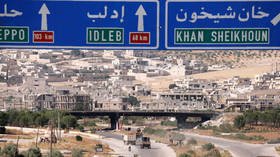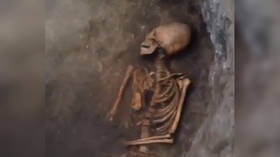Scientific paper arguing Assad not responsible for Syria chemical attack shelved after Bellingcat-led backlash

Unidentified “issues” prompted a prestigious scientific journal to withhold publication of a report challenging the mainstream narrative on a 2017 Syrian chemical attack – after ‘citizen investigation’ outlet Bellingcat objected.
The report, authored by MIT professor emeritus Theodore Postol and six other experts, concludes that the Syrian government was not behind the alleged sarin attack which killed more than 80 people at Khan Sheikhoun in April 2017.
Experts warned at the time that responsibility could not be so quickly determined, but that did not stop US President Donald Trump from launching 59 cruise missiles at a Syrian airbase in response. He was widely praised for the swift action, with even liberal media and his usual ‘resistance’ critics fawning over the display of military might.
Also on rt.com RT tours fortified caves in Syria where terrorists planned assaults, made drones & filmed fake chemical attack videosA new study disputing the findings of US intelligence and UN investigators was due to be published in the Princeton University-based Science & Global Security (SGS) — but is mysteriously being held back following an “independent internal review of the editorial process” which threw up unidentified “issues” with the peer-review and revision process.
It appears that the so-called issues were only discovered after the journal came under a barrage of public criticism for daring to publish an alternative view. In a note on the front page of its website, the journal’s editors said “questions have been asked” of its decision to publish the report, which prompted the review. The Khan Sheikhoun attack — and who was behind it — has been hotly disputed over the last two years, with anyone daring to question the mainstream narrative labelled an “Assad apologist.”
Yet, the “only thing” that should matter is whether the report is “technically correct,” Postol told RT after the journal decided to halt publication. “This is a science based journal, and if there [are] any technical errors in it, they need to point them out," he said, adding the criticisms are coming “from people who have no technical expertise.”
Also on rt.com RT films inside liberated town of Khan Sheikhoun in Syria’s Idlib province (VIDEO)That is likely a reference to the controversial Bellingcat, a ‘citizen investigation’ outlet funded by US, UK and other Western governments and foundations. Its founder Eliot Higgins has no scientific training whatsoever, but nonetheless shot to prominence over his “open source” online “investigations” — the results of which seem to fit perfectly with US and UK government narratives and are instantly caught by Western media. Higgins published a critique of the scientific paper last month and has previously branded the accomplished MIT professor an“idiot.”
"What's sad, is that a journal that's supposed to be dedicated to scientific enquiry and that is supposed to be dedicated to disarmament and arms control, is apparently being bullied or allowing itself to be bullied into political censorship and bias,” investigative journalist Rick Sterling told RT of SGS’s decision to halt the publication.
Evidence tampering?
The study, which was instigated by Goong Chen, a professor of applied mathematics at Texas A&M University in College Station, focuses on an impact crater in the road where the sarin gas was allegedly released. A report by the UN and Organization for the Prohibition of Chemical Weapons (OPCW) report concluded the crater was made from a bomb dropped from a plane, which would implicate the Syrian government. Chen’s models, however, suggest that it was formed by an artillery rocket with an explosive warhead.
Also on rt.com After 5 yrs under jihadist control, militants flee Syrian town where 2017 ‘chemical attack’ occurredPostol and Chen’s report also notes that a dead goat on the scene, allegedly killed by a nerve agent in the attack, could actually have been killed and dragged to the spot from another location. They point to the rope around its neck and markings on the ground that suggest evidence could have been tampered with.
The real irony in this battle of narratives is that, so far, experts have identified no technical faults with the new report — unlike the UN/OPCW assessment, which Postol said was “nearly impossible" to explain because it contains such “extraodrinary problems.” One of those problems, he said, is that while investigators said they found evidence of bombing on satellite imagery, the images in question actually show “no evidence of bomb damage.” Moreover, OPCW had no mandate to attribute responsibility at the time.
In spite of the evident concerns regarding the accuracy of the UN/OPCW report, its assessment has been held up as gospel truth in the mainstream Western media, while the Chen-Postol report is being attacked.
Also on rt.com Bellingcat unloads 4,000-word piece on Tulsi Gabbard over her questioning Syria chemical attacksPostol said he believes it would be a “very big mistake” if the SGS allowed itself to be pressured by people with no scientific basis for their criticism, but added that he had “very high confidence in the integrity” of the journal.
Asked what he believes really happened at Khan Sheikhoun, Postol said he had “extensive discussions” about the incident with Seymour Hersh – the Pulitzer Prize-winning investigative journalist, who exposed US atrocities in Vietnam and torture in Iraq. An article published by Hersh in June 2017 claims the casualties in the attack were actually caused when conventional explosives damaged a building containing chemicals and produced a toxic cloud.
Everything Hersh found is “exactly correct relative to the technical underpinnings," Postol said.
Mainstream media in the West has given little attention to the findings of Hersh, Postol or any of the other experts involved in producing the new report, preferring to stick to a predetermined narrative of Syrian guilt pushed by Bellingcat.
Like this story? Share it with a friend!














